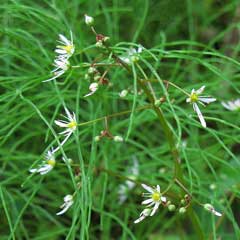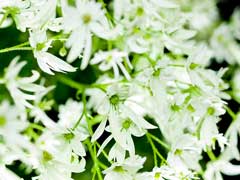 |
|
www.flickr.com/photos/tanaka_juuyoh |
 |
| www.flickr.com/photos/kodamatic |
Translate this page:
Summary
Bloom Color: White. Main Bloom Time: Late fall. Form: Rounded.
Physical Characteristics

 Saxifraga fortunei is a PERENNIAL growing to 0.4 m (1ft 4in) by 0.4 m (1ft 4in) at a medium rate.
Saxifraga fortunei is a PERENNIAL growing to 0.4 m (1ft 4in) by 0.4 m (1ft 4in) at a medium rate.
See above for USDA hardiness. It is hardy to UK zone 7 and is not frost tender. It is in flower from September to October. The species is hermaphrodite (has both male and female organs).
Suitable for: light (sandy), medium (loamy) and heavy (clay) soils. Suitable pH: mildly acid, neutral and basic (mildly alkaline) soils. It can grow in semi-shade (light woodland). It prefers moist soil.
UK Hardiness Map
US Hardiness Map
Synonyms
Plant Habitats
Woodland Garden Dappled Shade; Shady Edge; North Wall. In. East Wall. In.
Edible Uses
Edible Parts: Leaves
Edible Uses:
Young leaves - cooked[105]. They are added to soups or cooked with rice[177].
References More on Edible Uses
Medicinal Uses
Plants For A Future can not take any responsibility for any adverse effects from the use of plants. Always seek advice from a professional before using a plant medicinally.
None known
References More on Medicinal Uses
The Bookshop: Edible Plant Books
Our Latest books on Perennial Plants For Food Forests and Permaculture Gardens in paperback or digital formats.

Edible Tropical Plants
Food Forest Plants for Hotter Conditions: 250+ Plants For Tropical Food Forests & Permaculture Gardens.
More

Edible Temperate Plants
Plants for Your Food Forest: 500 Plants for Temperate Food Forests & Permaculture Gardens.
More

More Books
PFAF have eight books available in paperback and digital formats. Browse the shop for more information.
Shop Now
Other Uses
References More on Other Uses
Cultivation details
Landscape Uses:Alpine garden, Container, Ground cover, Massing, Rock garden, Woodland garden. Prefers a cool position in a moist humus-rich soil[1]. Prefers an acid soil[200]. Grows well in light woodland[200] or in a shady position in a rock garden. The plant is hardy to at least -15°c[187], the leaves and the flowers, however, are liable to be damaged by autumn frosts[200]. A polymorphic species[58], there are several named forms selected for their ornamental value[187]. Special Features:Attractive foliage, Naturalizing.
References Carbon Farming Information and Carbon Sequestration Information
Temperature Converter
Type a value in the Celsius field to convert the value to Fahrenheit:
Fahrenheit:
The PFAF Bookshop
Plants For A Future have a number of books available in paperback and digital form. Book titles include Edible Plants, Edible Perennials, Edible Trees,Edible Shrubs, Woodland Gardening, and Temperate Food Forest Plants. Our new book is Food Forest Plants For Hotter Conditions (Tropical and Sub-Tropical).
Shop Now
Plant Propagation
Seed - we have no information for this species but suggest sowing the seed in a cold frame in the spring. Surface sow, or only just cover the seed, and make sure that the compost does not dry out. Prick out the seedlings into individual pots when they are large enough to handle and grow them on in the greenhouse or cold frame for their first winter. Plant them out in late spring after the last expected frosts. Division in spring. Larger divisions can be planted out direct into their permanent positions. We have found it best to pot up the smaller divisions and grow them on in a lightly shaded position in a cold frame, planting them out once they are well established in the summer.
Other Names
If available other names are mentioned here
Native Range
TEMPERATE ASIA: Russian Federation (Kurile Islands, Sakhalin (south)), China (Hubei Sheng, Jilin Sheng (south), Liaoning Sheng, Sichuan Sheng), Korea, Japan (Hokkaidô, Honshu, Kyushu, Shikoku)
Weed Potential
Right plant wrong place. We are currently updating this section.
Please note that a plant may be invasive in one area but may not in your area so it's worth checking.
Conservation Status
IUCN Red List of Threatened Plants Status :

| Related Plants
|
| Latin Name | Common Name | Habit | Height | Hardiness | Growth | Soil | Shade | Moisture | Edible | Medicinal | Other |
| Astilbe chinensis | Pumila Spirea,Chinese Astilbe | Perennial | 0.7 |
4-8
| M | LMH | S | MWe | 1 | 0 | 3 |
| Astilbe longicarpa | | Perennial | 1.0 |
0-0
| | LMH | S | M | 1 | 0 | 2 |
| Astilbe thunbergii | Astilbe | Perennial | 0.5 |
4-9
| M | LMH | SN | M | 1 | 0 | 3 |
| Bergenia ciliata | | Perennial | 0.3 |
6-9
| | LMH | SN | M | 1 | 2 | 3 |
| Bergenia cordifolia | Siberian-tea, Pigsqueak, Heartleaf Bergenia | Perennial | 0.3 |
3-9
| M | LMH | FSN | M | 0 | 0 | 3 |
| Bergenia crassifolia | Siberian Tea | Perennial | 0.3 |
3-7
| | LMH | FSN | M | 2 | 0 | 3 |
| Bergenia purpurascens | | Perennial | 0.5 |
4-8
| | LMH | SN | M | 0 | 2 | 3 |
| Chrysosplenium alternifolium | Golden Saxifrage, Alternate-leaf golden saxifrage, Iowa golden saxifrage | Perennial | 0.3 |
4-8
| | LMH | SN | MWe | 2 | 0 | 3 |
| Chrysosplenium americanum | Water Mat, American golden saxifrage | Perennial | 0.1 |
3-7
| | LMH | SN | MWe | 1 | 0 | 2 |
| Chrysosplenium carnosum | | Perennial | 0.1 |
-
| | LMH | SN | MWe | 0 | 2 | |
| Chrysosplenium oppositifolium | Golden Saxifrage | Perennial | 0.2 |
4-8
| | LMH | SN | MWe | 2 | 0 | 3 |
| Darmera peltata | Umbrella Plant, Indian rhubarb, Indian Rubarb, Indian Rubarb | Perennial | 1.2 |
5-8
| M | LMH | SN | WeWa | 2 | 0 | 3 |
| Heuchera americana | Rock Geranium, American alumroot, Alumroot, Coral Bells, Rock Geranium | Perennial | 0.5 |
4-9
| M | LM | SN | M | 0 | 3 | 2 |
| Heuchera cylindrica | Alum Root, Roundleaf alumroot, Alpine alumroot, Beautiful alumroot, Poker alumroot | Perennial | 0.5 |
4-8
| | LM | SN | M | 1 | 2 | 3 |
| Heuchera diversifolia | Alum Root, Crevice alumroot | Perennial | 0.6 |
4-8
| | LM | SN | M | 1 | 1 | 3 |
| Heuchera glabra | Alpine Heuchera | Perennial | 0.6 |
4-8
| | LM | SN | M | 1 | 1 | 3 |
| Heuchera micrantha | Alum Root, Crevice alumroot, Hartweg's alumroot, Coral Bells | Perennial | 0.7 |
4-9
| F | LM | SN | M | 1 | 2 | 3 |
| Heuchera sanguinea | Alum Root, Coralbells, Crimson Bells | Perennial | 0.5 |
4-10
| M | LM | SN | M | 0 | 0 | 3 |
| Heuchera versicolor | Pink alumroot | Perennial | 0.2 |
8-11
| | LM | SN | M | 0 | 1 | 3 |
| Mitella diphylla | Mitrewort, Twoleaf miterwort | Perennial | 0.4 |
3-7
| | LMH | SN | M | 0 | 1 | 2 |
| Parnassia cabulica | | Perennial | 0.0 |
-
| | LMH | SN | M | 0 | 2 | |
| Penthorum sedoides | Virginian Stonecrop, Ditch stonecrop | Perennial | 1.0 |
0-0
| | LMH | SN | WeWa | 1 | 2 | |
| Pimpinella saxifraga | Burnet Saxifrage, Solidstem burnet saxifrage | Perennial | 1.0 |
4-8
| | LMH | SN | DM | 2 | 2 | |
| Rodgersia podophylla | | Perennial | 1.3 |
-
| | LMH | SN | MWe | 1 | 0 | 3 |
| Saxifraga cortusifolia | | Perennial | 0.4 |
6-9
| | LMH | S | MWe | 1 | 0 | |
| Saxifraga fusca | | Perennial | 0.2 |
-
| | LMH | SN | M | 1 | 0 | |
| Saxifraga japonica | | Perennial | 0.3 |
-
| | LMH | SN | MWe | 1 | 0 | |
| Saxifraga mertensiana | Wood saxifrage | Perennial | 0.0 |
0-0
| | LMH | SN | MWe | 1 | 0 | |
| Saxifraga micranthidifolia | Mountain Lettuce, Lettuceleaf saxifrage | Perennial | 1.0 |
0-0
| | LMH | SN | M | 3 | 0 | |
|
|
Growth: S = slow M = medium F = fast. Soil: L = light (sandy) M = medium H = heavy (clay). pH: A = acid N = neutral B = basic (alkaline). Shade: F = full shade S = semi-shade N = no shade. Moisture: D = dry M = Moist We = wet Wa = water.
Now available:
Food Forest Plants for Mediterranean Conditions
350+ Perennial Plants For Mediterranean and Drier Food Forests and Permaculture Gardens.
[Paperback and eBook]
This is the third in Plants For A Future's series of plant guides for food forests tailored to
specific climate zones. Following volumes on temperate and tropical ecosystems, this book focuses
on species suited to Mediterranean conditions—regions with hot, dry summers and cool, wet winters,
often facing the added challenge of climate change.
Read More
Expert comment
Author
Hook.f.
Botanical References
58200266
Links / References
For a list of references used on this page please go here
Readers comment
© 2010, Plants For A Future. Plants For A Future is a charitable company limited by guarantee, registered in England and Wales. Charity No. 1057719, Company No. 3204567.